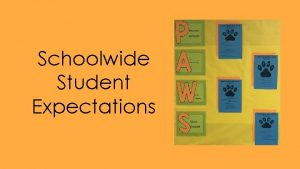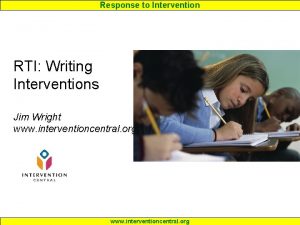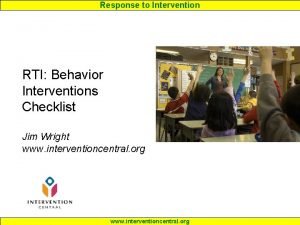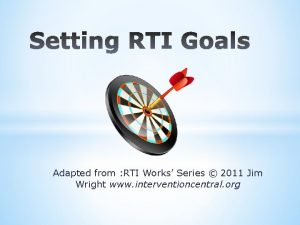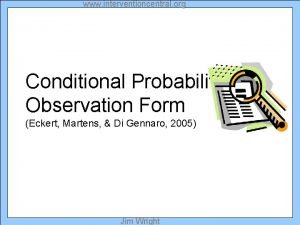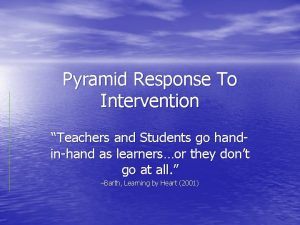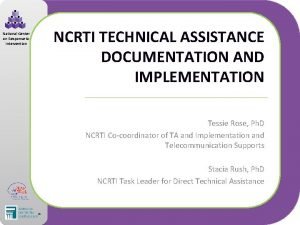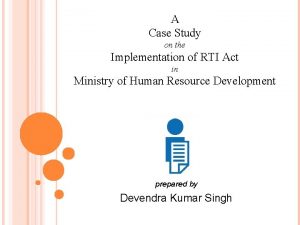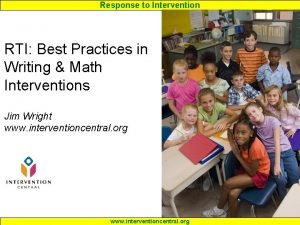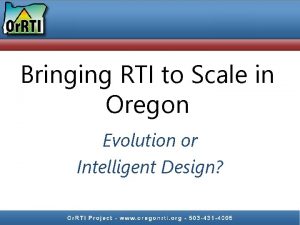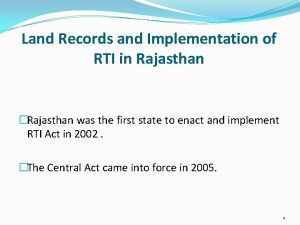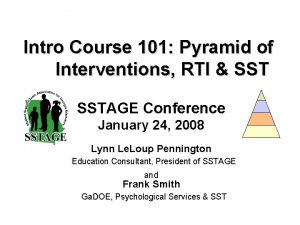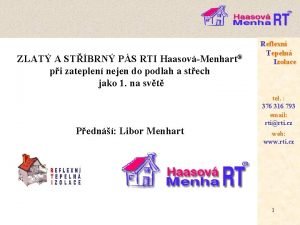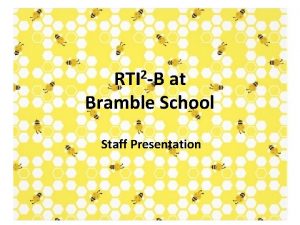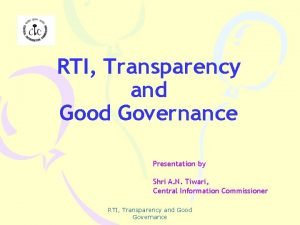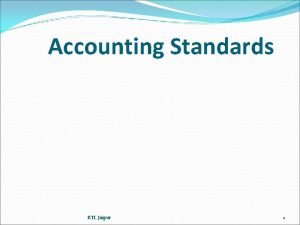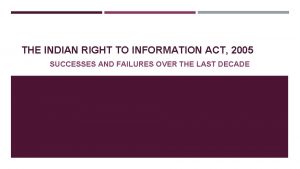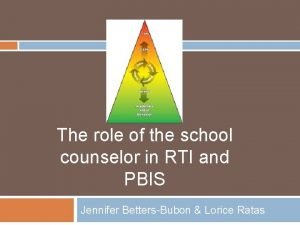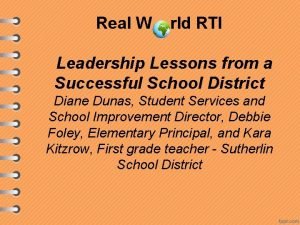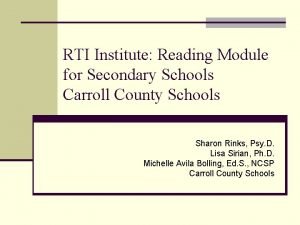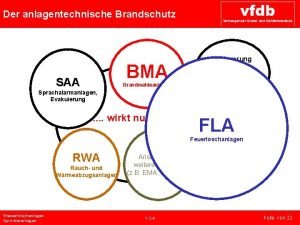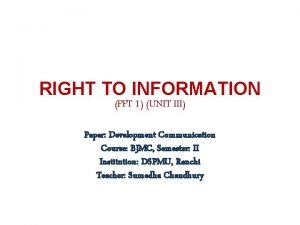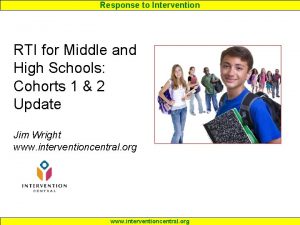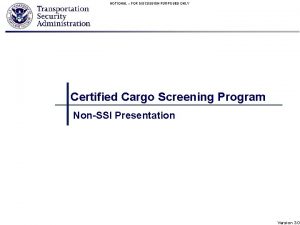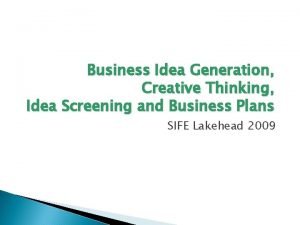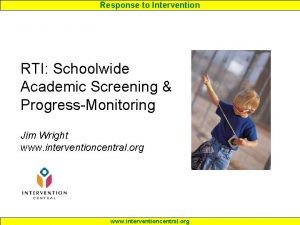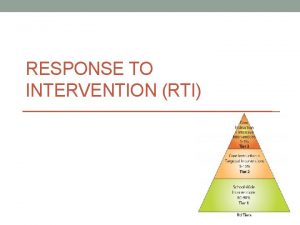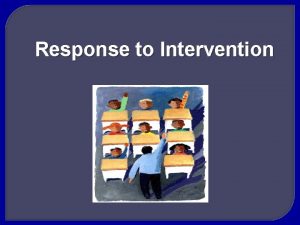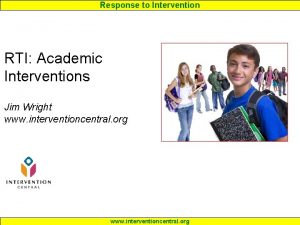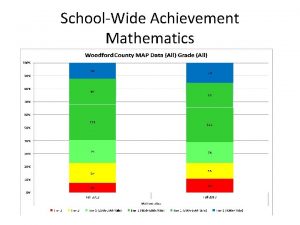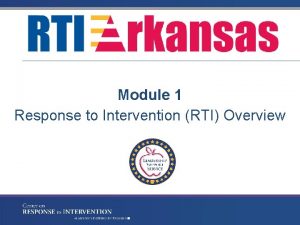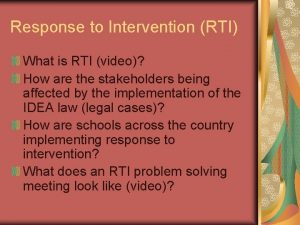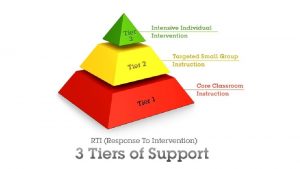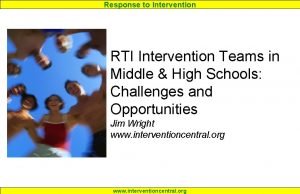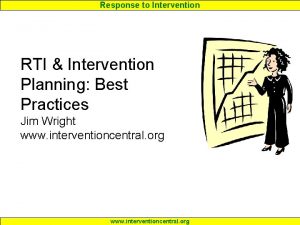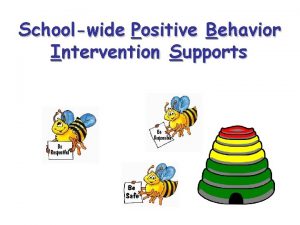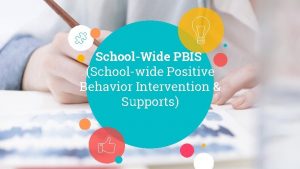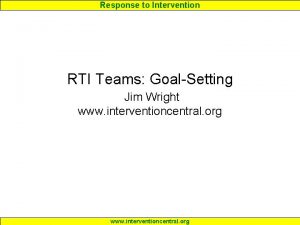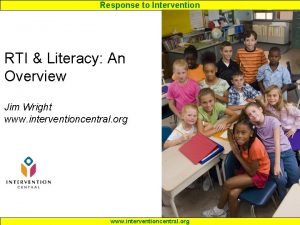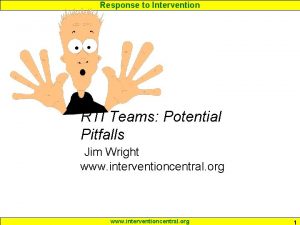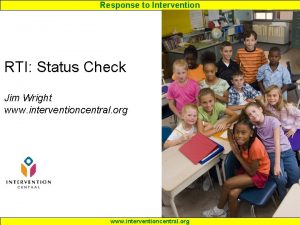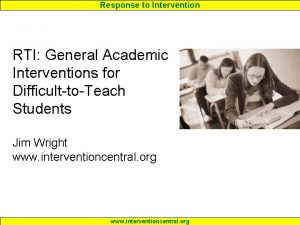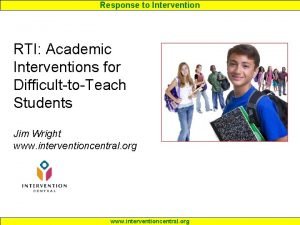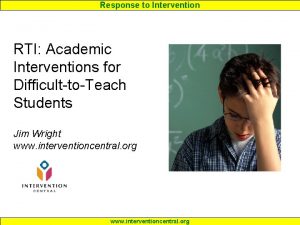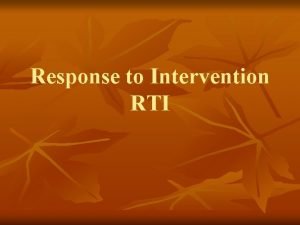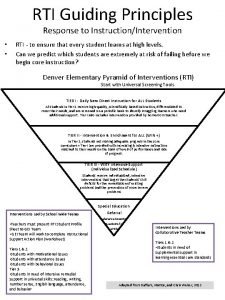Response to Intervention RTI Schoolwide Academic Screening Jim





































- Slides: 37

Response to Intervention RTI: Schoolwide Academic Screening Jim Wright www. interventioncentral. org

Response to Intervention RTI Literacy: Assessment & Progress-Monitoring • • • To measure student ‘response to instruction/intervention’ effectively, the RTI model measures students’ academic performance and progress on schedules matched to each student’s risk profile and intervention Tier membership. Benchmarking/Universal Screening. All children in a grade level are assessed at least 3 times per year on a common collection of academic assessments. Strategic Monitoring. Students placed in Tier 2 (supplemental) reading groups are assessed 1 -2 times per month to gauge their progress with this intervention. Intensive Monitoring. Students who participate in an intensive, individualized Tier 3 intervention are assessed at least once per week. Source: Burns, M. K. , & Gibbons, K. A. (2008). Implementing response-to-intervention in elementary and secondary schools: Procedures to assure scientific-based practices. New York: Routledge. www. interventioncentral. org 2

Response to Intervention Educational Decisions and Corresponding Types of Assessment • SCREENING/BENCHMARKING DECISIONS: Tier 1: Brief screenings to quickly indicate whether students in the general-education population are academically proficient or at risk. • PROGRESS-MONITORING DECISIONS: At Tiers and 3, ongoing ‘formative’ assessments to judge whether students on intervention are making adequate progress. • INSTRUCTIONAL/DIAGNOSTIC DECISIONS: At any Tier, detailed assessment to map out specific academic deficits , discover the root cause(s) of a student’s academic problem. • OUTCOME DECISIONS: Summative assessment (e. g. , state tests) to evaluate the effectiveness of a program. Source: Hosp, M. K. , Hosp, J. L. , & Howell, K. W. (2007). The ABCs of CBM: A practical guide to curriculum-based measurement. New York: Guilford Press. www. interventioncentral. org 3

Response to Intervention Curriculum-Based Measurement: An Introduction www. interventioncentral. org

Response to Intervention Curriculum-Based Measurement: Advantages as a Set of Tools to Monitor RTI/Academic Cases • Aligns with curriculum-goals and materials • Is reliable and valid (has ‘technical adequacy’) • Is criterion-referenced: sets specific performance levels for specific tasks • Uses standard procedures to prepare materials, administer, and score • Samples student performance to give objective, observable ‘low-inference’ information about student performance • Has decision rules to help educators to interpret student data and make appropriate instructional decisions • Is efficient to implement in schools (e. g. , training can be done quickly; the measures are brief and feasible for classrooms, etc. ) Source: M. K. , Hosp, data J. L. , & that Howell, can K. W. (2007). The ABCs of CBM. Newvisual York: Guilford. • Hosp, Provides be converted into displays www. interventioncentral. org 5

Response to Intervention Among other areas, CBM Techniques have been developed to assess: • • Reading fluency Reading comprehension Math computation Writing Spelling Phonemic awareness skills Early math skills www. interventioncentral. org 6

Response to Intervention Measuring General vs. Specific Academic Outcomes General Outcome Measures… • Track the student’s increasing proficiency on general curriculum goals such as reading fluency. Example: CBM -Oral Reading Fluency (Hintz et al. , 2006). • Are most useful for longer-term measurement (e. g. , to set and track IEP goals over the timespan of a school Sources: Burns, M. K. , & Gibbons, K. A. (2008). Implementing response-to-intervention in elementary and secondary schools: Procedures to assure scientific-based practices. New York: Routledge. year). Hintz, J. M. , Christ, T. J. , & Methe, S. A. (2006). Curriculum-based assessment. Psychology in the Schools, 43, 45 -56. www. interventioncentral. org 7

Response to Intervention Measuring General vs. Specific Academic Outcomes Specific Sub-Skill Mastery Measures… • Track short-term student academic progress with clear criteria for mastery (Burns & Gibbons, 2008). Example: Letter Identification. • Are helpful in assessing whether the student has acquired short-term skills whose acquisition may require weeks rather than months. Sources: Burns, M. K. , & Gibbons, K. A. (2008). Implementing response-to-intervention in elementary and secondary schools: Procedures to assure scientific-based practices. New York: Routledge. Hintz, J. M. , Christ, T. J. , & Methe, S. A. (2006). Curriculum-based assessment. Psychology in the Schools, 43, 45 -56. www. interventioncentral. org 8

Response to Intervention CBM: Developing a Process to Screen and Collect Local Norms Jim Wright www. interventioncentral. org

Response to Intervention Building-Wide Screening: Assessing All Students (Stewart & Silberglit, 2008) Screening data in basic academic skills are collected at least 3 times per year (fall, winter, spring). • Schools should consider using ‘curriculumlinked’ measures such as Curriculum. Based Measurement that will show generalized student growth in response to learning. • If possible, schools should consider ‘curriculum-locked’ Source: avoiding Stewart, L. H. & Silberglit, B. (2008). Best practices in developingmeasures academic local norms. that In A. Thomas & J. Grimes (Eds. ), Best practices in school psychology V (pp. 225 -242). Bethesda, MD: Nationalare Association of School tied to Psychologists. a www. interventioncentral. org single commercial instructional 10

Response to Intervention Building-Wide Screening: Using a Wide Variety of Data (Stewart & Silberglit, 2008) Screenings can be compiled using: • Fluency measures such as Curriculum. Based Measurement. • Existing data, such as office disciplinary referrals. • Computer-delivered assessments, e. g. , Measures of Academic Progress (MAP) from www. nwea. org Source: Stewart, L. H. & Silberglit, B. (2008). Best practices in developing academic local norms. In A. Thomas & J. Grimes (Eds. ), Best practices in school psychology V (pp. 225 -242). Bethesda, MD: National Association of School Psychologists. www. interventioncentral. org 11

Response to Intervention Measures of Academic Progress (MAP) www. nwea. org www. interventioncentral. org 12

Response to Intervention Applications of Screening Data (Stewart & Silberglit, 2008) Screening data can be used to: • Evaluate and improve the current core instructional program. • Allocate resources to classrooms, grades, and buildings where student academic needs are greatest. • Guide the creation of targeted Tier 2 (supplemental intervention) groups • Set academic goals for improvement for students on Tier 2 and Tier 3 interventions. • Move students across levels of intervention, based on performance relative to that of Source: Stewart, L. H. & Silberglit, B. (2008). Best practices in developing academic local norms. In A. peers (local norms). Thomas & J. Grimes (Eds. ), Best practices in school psychology V (pp. 225 -242). Bethesda, MD: National Association of School Psychologists. www. interventioncentral. org 13

Response to Intervention Screening Data: Supplement With Additional Academic Testing as Needed (Stewart & Silberglit, 2008) “At the individual student level, local norm data are just the first step toward determining why a student may be experiencing academic difficulty. Because local norms are collected on brief indicators of core academic skills, other sources of information and additional testing using the local norm measures or other tests are needed to validate the problem and determine why the student is having difficulty. … Percentage correct and rate information provide clues regarding automaticity and accuracy of skills. Error types, error patterns, and qualitative data provide clues about how a student approached the task. Patterns of strengths and weaknesses on subtests of an assessment can provide information about the concepts in which a student or group of students may need greater instructional support, provided these Source: subtests Stewart, L. H. & Silberglit, B. (2008). and Best practices in developing academic local norms. In A. are equated reliable for these Thomas & J. Grimes (Eds. ), Best practices in school psychology V (pp. 225 -242). Bethesda, MD: p. Psychologists. 237 www. interventioncentral. org Nationalpurposes. ” Association of School 14

Response to Intervention Steps in Creating Process for Local Norming/Screening Using CBM Measures 1. Identify personnel to assist in collecting data. A range of staff and school stakeholders can assist in the school norming, including: • • Administrators Support staff (e. g. , school psychologist, school social worker, specials teachers, paraprofessionals) • Parents and adult volunteers • Field placement students from graduate Source: Harn, B. (2000). Approaches and considerations of collecting schoolwide early literacy and programs reading performance data. University of Oregon: Retrieved from https: //dibels. uoregon. edu/logistics/data_collection. pdf www. interventioncentral. org 15

Response to Intervention Steps in Creating Process for Local Norming/Screening Using CBM Measures 2. Determine method for screening data collection. The school can have teachers collect data in the classroom or designate a team to conduct the screening: • In-Class: Teaching staff in the classroom collect the data over a calendar week. • Schoolwide/Single Day: A trained team of 6 -10 sets up a testing area, cycles students through, and collects all data in one school day. • Schoolwide/Multiple Days: Trained team of 4 -8 either goes to classrooms or creates a central testing location, completing the assessment over multiple days. • Within-Grade: Data collectors at a grade level norm the Source: Harn, B. (2000). Approaches and considerations of collecting schoolwide early literacy and entire grade, with students kept reading performance data. University of Oregon: Retrieved from busy with another activity https: //dibels. uoregon. edu/logistics/data_collection. pdf www. interventioncentral. org (e. g. , video) when not being screened. 16

Response to Intervention Steps in Creating Process for Local Norming/Screening Using CBM Measures 3. Select dates for screening data collection. Data collection should occur at minimum three times per year in fall, winter, and spring. Consider: • • Avoiding screening dates within two weeks of a major student break (e. g. , summer or winter break). Coordinate the screenings to avoid state testing periods and other major scheduling conflicts. Source: Harn, B. (2000). Approaches and considerations of collecting schoolwide early literacy and reading performance data. University of Oregon: Retrieved from https: //dibels. uoregon. edu/logistics/data_collection. pdf www. interventioncentral. org 17

Response to Intervention Steps in Creating Process for Local Norming/Screening Using CBM Measures 4. Create Preparation Checklist. Important preparation steps are carried out, including: • • Selecting location of screening Recruiting screening personnel Ensure that training occurs for all data collectors Line up data-entry personnel (e. g. , for rapid computer data entry). Source: Harn, B. (2000). Approaches and considerations of collecting schoolwide early literacy and reading performance data. University of Oregon: Retrieved from https: //dibels. uoregon. edu/logistics/data_collection. pdf www. interventioncentral. org 18

Response to Intervention Methods of Classroom Data Collection Jim Wright www. interventioncentral. org

Response to Intervention Activity: Classroom Methods of Data Collection In your teams: • Review the potential sources of classroom data Classroom Data that can be used to monitor Sources: Tier 1 interventions. • Existing records • Global skills checklist • What questions do you have about any of these • Rating scales data sources? • Behavioral frequency count • How can your school make full use of these data • Behavioral log sources to ensure that • Student work samples every Tier 1 intervention is • Work performance logs www. interventioncentral. org

Response to Intervention RTI ‘Pyramid of Interventions’ Tier 3 Tier 2 Tier 1 Tier 3: Intensive interventions. Students who are ‘non-responders’ to Tiers 1 & 2 are referred to the RTI Team for more intensive interventions. Tier 2 Individualized interventions. Subset of students receive interventions targeting specific needs. Tier 1: Universal interventions. Available to all students in a classroom or school. Can consist of whole-group or individual www. interventioncentral. org 21

Response to Intervention www. interventioncentral. org 22

Response to Intervention Existing Records • Description: The teacher uses information already being collected in the classroom that is relevant to the identified student problem. • Examples of existing records that can be used to track student problems include: – Grades – Absences and incidents of tardiness – Homework turned in www. interventioncentral. org 23

Response to Intervention Global Skills Checklists • Description: The teacher selects a global skill. The teacher then breaks that global skill down into specific, observable ‘subskills’. Each subskill can be verified as ‘done’ or ‘not done’. www. interventioncentral. org 24

Response to Intervention Global Skills Checklists: Example • The teacher selects the global skill ‘organizational skills’. • That global skill is defined as having the following components, each of which can be observed: qarriving to class on time; qbringing work materials to class; qfollowing teacher directions in a timely manner; qknowing how to request teacher assistance when needed; qhaving an uncluttered desk with only www. interventioncentral. org 25

Response to Intervention Behavioral Frequency Count • Description: The teacher observes a student behavior and keeps a cumulative tally of the number of times that the behavior is observed during a given period. • Behaviors that are best measured using frequency counts have clearly observable beginning and end points—and are of relatively short duration. Examples include: – Student call-outs. – Requests for teacher help during independent seatwork. – Raising one’s hand to make a contribution www. interventioncentral. org to large-group discussion. 26

Response to Intervention Behavioral Frequency Count: How to Record Teachers can collect data on the frequency of student behaviors in several ways: • Keeping a mental tally of the frequency of target behaviors occurring during a class period. • Recording behaviors on paper (e. g. , simple tally marks) as they occur. • Using a golf counter, stitch counter, or other mechanical counter device to www. interventioncentral. org 27

Response to Intervention Behavioral Frequency Count: How to Compute • If student behaviors are being tallied during a class period, frequency-count data can be reported as ‘X number of behaviors per class period’. • If frequency-count data is collected in different spans of time on different days, however, schools can use the following method to standardize frequency count data : – Record the total number of behaviors observed. – Record the number of minutes in the observation period. – Divide the total number of behaviors observed by total minutes in the observation period. Example: 5 callouts observed during a 10 www. interventioncentral. org 28

Response to Intervention Behavior Log • Description: The teacher makes a log entry each time that a behavior is observed. An advantage of behavior logs is that they can provide information about the context within which a behavior occurs. (Disciplinary office referrals are a specialized example of a behavior log. ) • Behavior logs are useful for tracking ‘low-incidence’ problem behaviors. www. interventioncentral. org 29

Response to Intervention Behavior Log: Sample Form www. interventioncentral. org 30

Response to Intervention Rating Scales • Description: A scale is developed that a rater can use to complete a global rating of a behavior. Often the rating scale is completed at the conclusion of a fixed observation period (e. g. , after each class period). • Daily / Direct Behavior Report Cards are one example of rating scales. www. interventioncentral. org 31

Response to Intervention Daily Behavior Report Card: Daily Version Jim Blalock Mrs. Williams www. interventioncentral. org May 5 Rm 108

Response to Intervention Student Work Samples • Description: Work samples are collected for information about the student’s basic academic skills, mastery of course content, etc. • Recommendation: When collecting work samples: – Record the date that the sample was collected – If the work sample was produced in class, note the amount of time needed to complete the sample (students can calculate and record this information). www. interventioncentral. org 33

Response to Intervention Work Performance Logs • Description: Information about student academic performance is collected to provide insight into growth in student skills or use of skills in appropriate situations. Example: A teacher implementing a vocabulary-building intervention keeps a cumulative log noting date and vocabulary words mastered. • Example: A student keeps a journal with www. interventioncentral. org 34

Response to Intervention Timed Tasks (e. g. , Curriculum-Based Measurement) • Description: The teacher administers structured, timed tasks to assess student accuracy and fluency. • Example: The student completes a 2 minute CBM single-skill math computation probe. • Example: The student completes a 3 minute CBM writing probe that is scored for total words written. www. interventioncentral. org 35

Response to Intervention Combining Classroom Monitoring Methods • Often, methods of classroom data collection and progress-monitoring can be combined to track a single student problem. • Example: A teacher can use a rubric (checklist) to rate the quality of student work samples. • Example: A teacher may keep a running tally (behavioral frequency count) of student callouts. At the same time, the www. interventioncentral. org 36

Response to Intervention Activity: Classroom Methods of Data Collection In your teams: • Review the potential sources of classroom data Classroom Data that can be used to monitor Sources: Tier 1 interventions. • Existing records • Global skills checklist • What questions do you have about any of these • Rating scales data sources? • Behavioral frequency count • How can your school make full use of these data • Behavioral log sources to ensure that • Student work samples every Tier 1 intervention is • Work performance logs www. interventioncentral. org
 Schoolwide expectations
Schoolwide expectations Difference between right and wright
Difference between right and wright Rti behavior checklist
Rti behavior checklist Jim wright rti
Jim wright rti Jim wright intervention central
Jim wright intervention central Simplifying response to intervention
Simplifying response to intervention Response to intervention pyramid
Response to intervention pyramid National center for response to intervention
National center for response to intervention Ncrti
Ncrti Rti case study
Rti case study Rti code
Rti code Rti interventions list
Rti interventions list Rti oregon
Rti oregon Rti portal rajasthan
Rti portal rajasthan Rti interventions examples
Rti interventions examples Rti izolace
Rti izolace Rti 2
Rti 2 Transparency of good governance
Transparency of good governance Serp.louisiana.doe
Serp.louisiana.doe Rti jaipur
Rti jaipur Rti zeromq
Rti zeromq Rti act 2005 introduction
Rti act 2005 introduction Rti examples
Rti examples Rti meaning real estate
Rti meaning real estate Upper rti
Upper rti Rti graph
Rti graph Pegasus payroll auto enrolment
Pegasus payroll auto enrolment Seitenwandsprinkler sprühbild
Seitenwandsprinkler sprühbild Hmrc rti gtax
Hmrc rti gtax Right to information act 2005 ppt
Right to information act 2005 ppt Ragan technologies san diego
Ragan technologies san diego Rti sceduler
Rti sceduler A subsequent
A subsequent Natural response and forced response
Natural response and forced response Natural response circuit
Natural response circuit Zoho and background screening
Zoho and background screening Tsa certified cargo screening program
Tsa certified cargo screening program Problem inventory analysis example
Problem inventory analysis example
